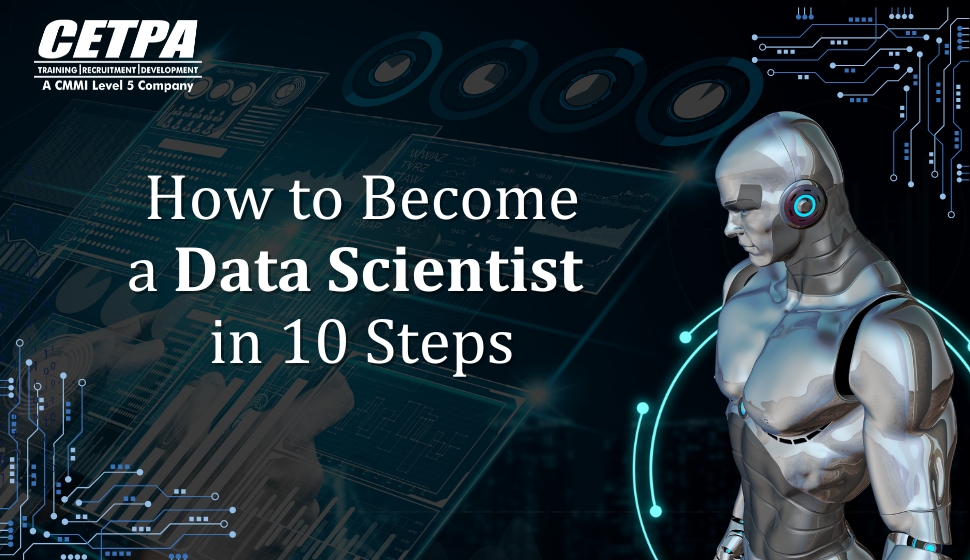The role of a data scientist has become one of the most rewarding and in-demand jobs in today’s data-driven world. Data scientists are instrumental in extracting insights from large volumes of data, driving business decisions, and innovating across various industries. Are you looking to build a career in data science and aspire to become a data scientist? Here’s a comprehensive guide of 10 steps to help you embark on this exciting journey.
What is a data scientist?
The individual who examines vast amounts of data to find patterns, trends, and insights which help businesses to make data-driven decisions is known as a data scientist. They are skilled in statistical analysis, machine learning methods, and programming languages like R or Python. In order to efficiently handle business difficulties, data scientists are skilled in data manipulation, visualization, and result analysis. They combine technical proficiency with domain knowledge to provide actionable insights and drive strategic decisions across various industries.

10 steps on how you can become a data scientist:
- Step 1: Understand the Role: Before diving into the specifics, it’s crucial to have a clear understanding of what a data scientist does. Essentially, a data scientist analyzes complex data to uncover patterns, trends, and insights that organizations can leverage to make informed decisions. For solving difficult problems, they combine topic expertise, technical expertise, and analytical ability.
- Step 2: Master the Fundamentals: A solid foundation in mathematics, statistics, and computer science forms the bedrock of data science.Either take data science training to learn about topics like linear algebra, calculus, probability, and algorithms through or you can choose to do self study.Learn certain programming languages such as Python or R, as they are frequently utilized in data science for analysis, visualization, and manipulation of data.
- Step 3: Learn Data Wrangling and Exploration: Data rarely comes in a clean, ready-to-use format. Data wrangling involves cleaning, transforming, and organizing raw data into a usable form for analysis. Proficiency in tools like pandas (Python) or dplyr (R) for data manipulation and exploratory data analysis (EDA) techniques is essential.
- Step 4: Dive into Machine Learning: Machine learning is a core component of data science, enabling computers to learn from data and make predictions or decisions. Study machine learning algorithms such as linear regression, decision trees, and clustering techniques.Learn how to evaluate model performance and adjust hyperparameters to achieve optimal outcomes.
- Step 5: Gain Proficiency in Data Visualization: Data visualization is crucial for communicating insights effectively to stakeholders. Learn libraries like Matplotlib, Seaborn (Python), or ggplot2 (R) to create meaningful visual representations of data. Understand principles of effective visualization and storytelling with data.
- Step 6: Understand Big Data Technologies: In today’s era of big data, familiarity with tools and frameworks like Hadoop, Spark, or SQL is advantageous. Learn how to handle and process large datasets efficiently using these technologies. Cloud platforms like AWS, Google Cloud, or Azure offer services for scalable data storage and computation.
- Step 7: Develop Business Acumen: Data scientists not only crunch numbers but also translate their findings into actionable insights that drive business decisions. Understand the industry you aim to work in and learn to align data solutions with business goals. Communication skills are vital to convey complex technical findings to non-technical stakeholders.
- Step 8: Build a Portfolio of Projects: Hands-on experience is invaluable in mastering data science. Work on projects that showcase your skills in data cleaning, analysis, modeling, and visualization. Kaggle competitions, open-source contributions, or personal projects based on real-world datasets are excellent ways to build a portfolio.
- Step 9: Stay Updated and Network: The field of data science is fast developing, with new methods, resources, and approaches appearing all the time. Attend conferences and meetups, write research papers, blogs, and take online courses to stay updated. Making connections with industry experts through networking can lead to career possibilities, mentorship, and insightful information.
- Step 10: Pursue Continuous Learning and Growth: Data science is an ongoing learning process. Have a mindset of development and be prepared to adjust to unexpected circumstances and technological advancements. To expand your skill set, think about studying advanced subjects like reinforcement learning, deep learning, or natural language processing (NLP).
Conclusion:
Becoming a data scientist requires dedication, a solid foundation in technical skills, and a passion for solving complex problems with data. By following these 10 steps mastering the fundamentals, gaining practical experience, and staying updated you can embark on a rewarding career in data science. So, why wait? Enroll in a Data Science Training in Hyderabad or elsewhere now and enhance your skills in data science. Also remember, persistence and enthusiasm are key to mastering this dynamic and impactful field.



